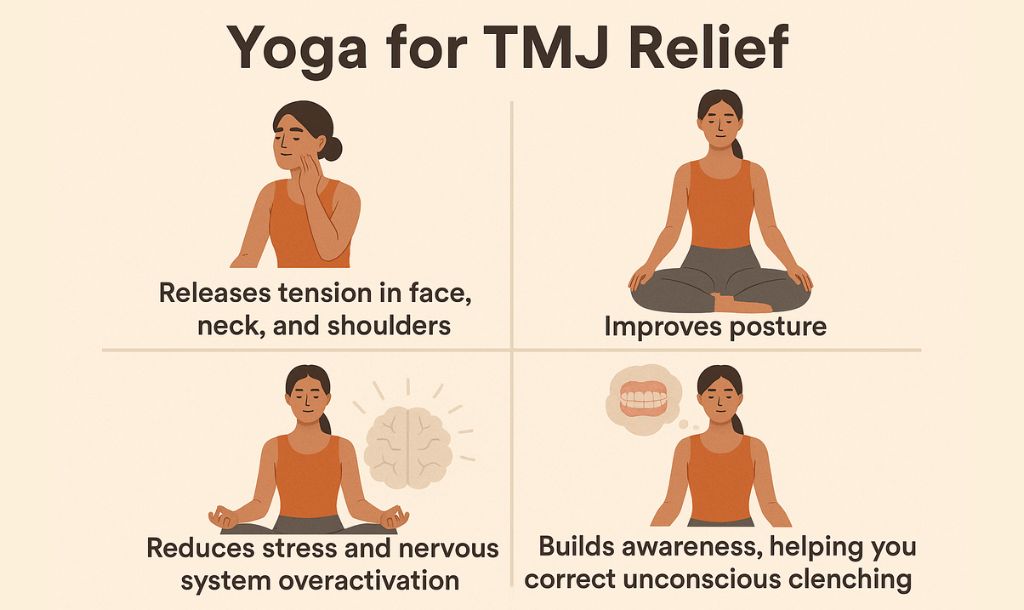What is Supta Matsyendrasana (Supine Spinal Twist)?
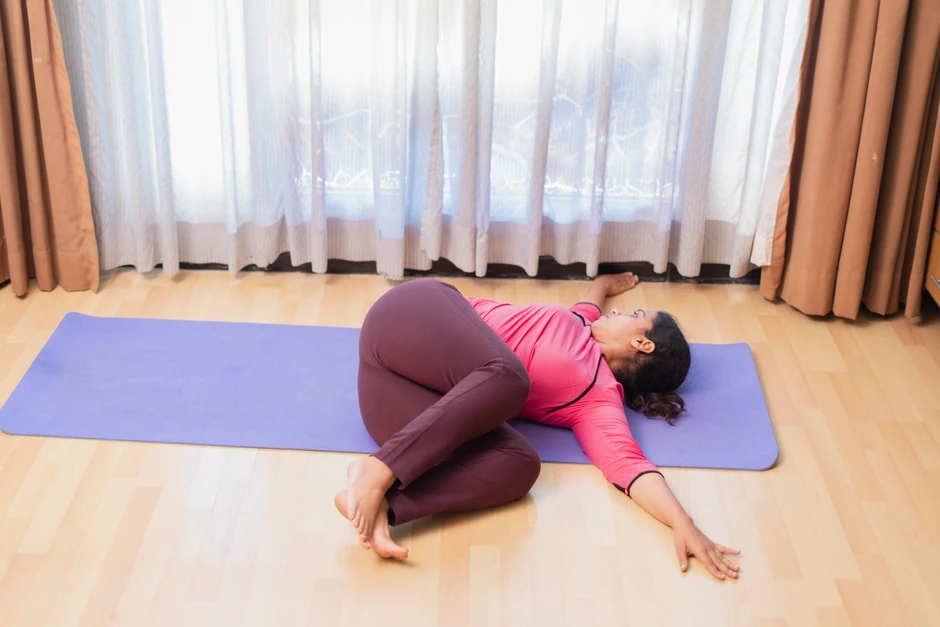
Supta Matsyendrasana (Supine Spinal Twist) is a gentle, reclining yoga pose that softly rotates the spine while you lie on your back. It releases tension from the lower back, hips, and shoulders, promotes spinal flexibility, and supports healthy digestion. This calming twist also helps relax the nervous system, making it a popular choice for restorative practices, cool-downs, and bedtime routines.
Whether you’re winding down from a long day or recovering from a workout, this pose invites deep release and relaxation.
Supine Spinal Twist: Overview & Meaning of Supta Matsyendrasana
The word Supta means “reclined” or “lying down,” Matsyendra refers to “Lord of the Fishes,” a legendary yogi said to have discovered the secrets of Hatha Yoga, and Asana means “pose” or “posture.”
Together, Supta Matsyendrasana translates to “Reclined Lord of the Fishes Pose.” It is the supine adaptation of the classical seated twist, Ardha Matsyendrasana, honoring Sage Matsyendranath, one of the first teachers of Hatha Yoga.
This pose has deep roots in yoga’s classical tradition, even though its modern reclining version evolved for greater accessibility and comfort. This gentle supine twist allows gravity to guide the movement, encouraging relaxation, stillness, and gentle spinal decompression. In modern yoga, it’s frequently used in restorative, yin, and therapeutic practices for its calming and healing effects.
At a Glance
- Sanskrit Name: सुप्त मत्स्येन्द्रासन (Supta Matsyendrasana)
- Pronunciation: SOOP-tah MAHT-see-en-DRAHS-anna
- English Names: Supine Spinal Twist, Reclined Spinal Twist, Supine Twist Pose
- Pose Type: Supine twist, restorative, spinal rotation
- Level: Beginner to Intermediate (accessible with modifications)
- Duration: 30 seconds to 5 minutes per side
Benefits of Supta Matsyendrasana (Supine Spinal Twist)
Supta Matsyendrasana offers a remarkable blend of physical, mental, and energetic benefits. This gentle reclining twist restores spinal balance, aids digestion, and encourages deep relaxation, making it one of the most restorative poses in yoga.
Below are the key physical, digestive, mental, and emotional benefits of practicing Supine Spinal Twist on a regular basis.
Physical Benefits
- Improves spinal mobility: The gentle spinal rotation enhances flexibility, relieves stiffness, and maintains healthy spinal alignment.
- Releases hip and lower back tension: The gentle twist eases tightness in the lumbar spine, hips, and glutes — especially helpful for relieving stiffness from long sitting or driving.
- Opens chest and shoulders: Counteracts rounded shoulders and forward-head posture, common among desk workers.
- Relieves sciatica discomfort: With mindful alignment, this pose eases mild sciatic nerve tension and supports spinal decompression.
- Improves posture and alignment: By rebalancing both sides of the body, Supta Matsyendrasana restores symmetry and neutral spine alignment.
- Enhances breathing capacity: The expansion through the ribcage opens intercostal muscles, allowing deeper and more efficient breathing.
Digestive & Detox Benefits
- Stimulates digestion: The twisting motion massages digestive organs, increasing peristalsis and improving nutrient absorption.
- Relieves constipation and bloating: The gentle pressure across the abdomen helps move trapped gas and supports regular bowel movement.
- Supports liver and kidney function: Twists naturally enhance circulation to detoxifying organs, assisting in the body’s cleansing processes.
- Aids elimination and metabolism: The rhythmic compression-decompression action rejuvenates internal organs and helps balance metabolism.
Mental & Emotional Benefits
- Promotes calm and reduces stress: The gentle, reclined twist activates the body’s relaxation response, encouraging deep breathing, mental ease, and a sense of calm.
- Improves sleep quality: Ideal before bedtime — this pose soothes the mind, reduces restlessness, and promotes restorative sleep.
- Releases emotional tension: Twists often release stored emotional stress held in the torso and abdomen.
- Promotes relaxation and mindfulness: Encourages awareness of subtle sensations and fosters inner stillness.
How to Do Supta Matsyendrasana (Supine Spinal Twist): Step-by-Step Guide
Supta Matsyendrasana (Supine Spinal Twist) is simple in appearance but deeply rejuvenating when done with awareness. Follow this gentle, step-by-step guide to experience the full benefits of the pose safely.
Part 1: Preparing for the Pose
Before practicing Supta Matsyendrasana, prepare your body with light movement and grounding breathwork.
1. Supine Knee-to-Chest Pose (Apanasana)
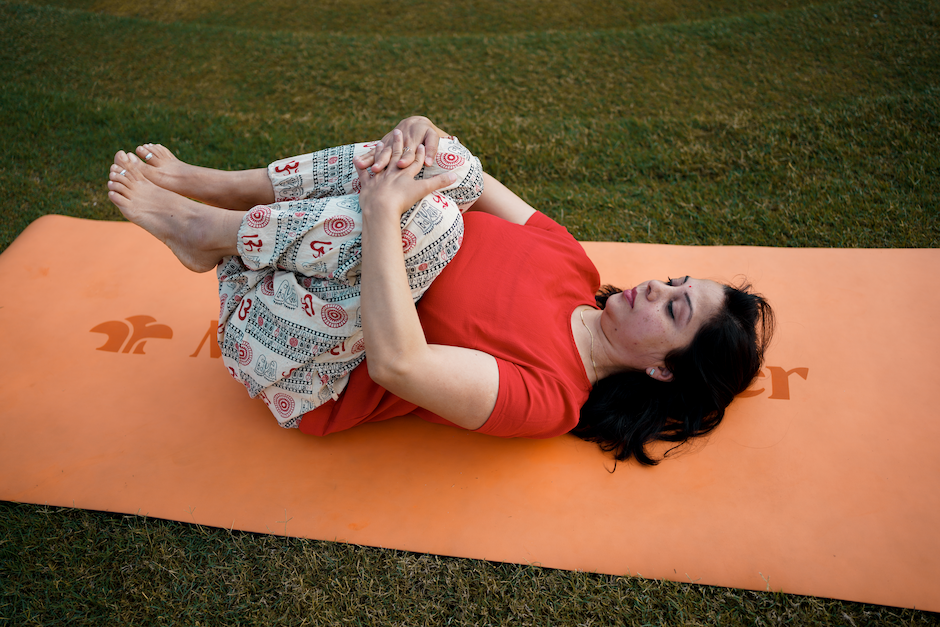
Warms up the lower back and relieves tension from the hips and spine.
- Lie on your back with legs extended and shoulders relaxed.
- Draw one or both knees toward your chest, holding your shins or knees with your hands.
- Keep your lower back gently pressed into the mat and breathe slowly for 5–8 breaths.
2. Gentle Supine Hip Circles
Loosens tight hip joints and improves circulation in the pelvic area.
- Lying on your back, hug one knee toward your chest.
- Begin to circle the knee slowly in one direction, then reverse.
- Switch sides after several circles, moving with your breath.
3. Reclined Butterfly Pose (Supta Baddha Konasana)
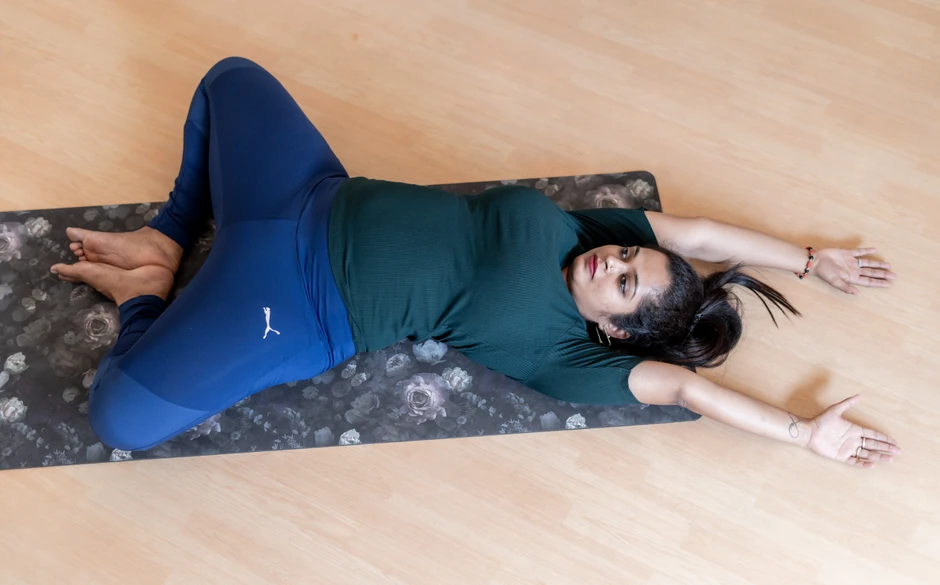
Opens the groin and inner thighs while calming the body and mind.
- Lie on your back and bring the soles of your feet together, knees falling open to the sides.
- Place pillows or blocks under your knees for support if needed.
- Rest your hands on your belly or by your sides and breathe deeply for 1–2 minutes.
4. Bridge Pose (Setu Bandhasana)
.webp)
Strengthens the glutes and spine while gently energizing the body.
- Lie on your back with knees bent, feet hip-width apart, and arms by your sides.
- Press into your feet to lift your hips toward the ceiling, keeping knees aligned.
- Hold for 3–5 breaths, then slowly lower down one vertebra at a time.
Part 2: How to Do Supine Twist (Supta Matsyendrasana): Step-by-Step Instructions
- Lie comfortably on your back with your legs extended, arms stretched out in a T-shape, and palms facing up; close your eyes and take a few steady breaths to relax.
- Bend both knees and draw them gently toward your chest, rocking slightly side to side to release your lower back.
- Extend your arms back out to shoulder height, palms up or down for comfort, keeping both shoulders grounded on the mat.
- As you exhale, lower both knees slowly to the right side, keeping them stacked or slightly apart, and allow gravity to guide them down without forcing the twist.
- Turn your head gently to the left, opposite to your knees, or keep it neutral if your neck feels tight.
- Deepen the twist by gently pressing your top knee with your right hand, or modify by placing a folded blanket or block under your knees for support.
- Hold the twist for 1–3 minutes, breathing deeply into your belly and allowing your body to soften with each exhale.
- Inhale to lift your knees back to center, hugging them gently toward your chest to neutralize the spine.
- Exhale and repeat the twist on the left side, turning your head to the right, and hold for the same duration.
- Return to center, hug your knees to your chest once more, then extend your legs long on the mat, resting in stillness or moving into Savasana.
Alignment & Safety Tips
- Keep both shoulders grounded as much as possible
- Avoid forcing knees to the floor
- Support knees with props if your back feels strained
- Move gently and slowly — never push into discomfort
- Keep your head neutral if you have neck sensitivity
- Engage your core slightly when returning to center
- Let gravity guide your twist, not effort
Learn Supine Twist step-by-step with a coach. Book a free 1-on-1 session today!
Supta Matsyendrasana Variations
Supta Matsyendrasana (Supine Spinal Twist) can be modified or deepened in countless ways to meet your level of flexibility, comfort, and energy on any given day. Whether you’re recovering from stiffness, exploring deeper releases, or looking to challenge your range, the variations below help you personalize the pose safely.
Beginner Modifications
1. Supported Supine Twist
Gently decompresses the spine and reduces pressure on the hips and lower back.
- Lie on your back and bring both knees toward your chest.
- Lower your knees to one side, placing a folded blanket or bolster under them for support.
- Stretch your arms out in a T-shape, keeping both shoulders grounded.
2. Feet-on-the-Wall Variation
Offers full control over the twist’s intensity and supports tight hamstrings.
- Sit sideways close to a wall, then lie down and extend your legs up the wall.
- Slide your feet gently down to one side until you feel a light twist through the spine.
- Adjust the depth by bending your knees or placing a blanket under your hips.
3. Single-Leg Twist (Half Supta Matsyendrasana)
Releases tension in one hip and side of the lower back at a time.
- Lie on your back with one leg extended and the other crossed over the body.
- Rest your top knee on a cushion or the floor while keeping your shoulders anchored.
- Turn your head opposite to the bent knee for a balanced twist.
4. Higher-Knee Position
Gentle on tight hips and lumbar spine while maintaining a mild spinal twist.
- Lie on your back, bend your knees, and twist them only partway toward the floor (about 45–60°).
- Support your legs with a pillow or block underneath.
- Keep both shoulders relaxed and grounded.
Intermediate Variations
5. Extended Leg Variation (Supta Matsyendrasana II)
Deepens hip, hamstring, and IT band flexibility.
- From the twist, extend your top leg straight across your body.
- Keep the bottom leg bent or straight on the floor.
- Use a strap to hold the extended leg if hamstrings are tight.
6. Eagle Legs Supine Twist
Intensifies stretch through the hips, outer thighs, and obliques.
- Cross one leg over the other in Garudasana (Eagle Pose) position.
- Lower both legs to one side, keeping your shoulders flat on the mat.
- Relax the legs and breathe evenly.
7. Arm Bind Variation
Compresses and massages the digestive organs while enhancing the spinal twist.
- Hug both knees into your chest and wrap your arms around them.
- Slowly drop the knees to one side while maintaining the bind.
- Keep your breath steady and avoid pulling.
Advanced Variations
8. Both Legs Extended Twist
Engages the full spinal column while stretching hips and hamstrings.
- Lie on your back, extend both legs, and lower them together to one side.
- Keep your shoulders grounded and move slowly to protect your spine.
- Hold for several breaths before switching sides.
9. Weighted Supine Twist
Encourages deeper release through gentle grounding pressure.
- Come into your twist and place a light sandbag or yoga weight on your top thigh.
- Keep your shoulders relaxed and allow the weight to enhance the stretch.
- Breathe deeply and release gradually.
Supta Matsyendrasana Precautions & Contraindications
Supta Matsyendrasana (Supine Spinal Twist) is a gentle and accessible yoga pose — but like any spinal rotation, it must be practiced with care. Listening to your body and knowing when to modify (or skip) the pose ensures safety and long-term benefits.

Avoid Supta Matsyendrasana If You Have:
- Recent abdominal or spinal surgery
- Acute disc herniation or severe back injury
- Advanced pregnancy (2nd or 3rd trimester)
- Uncontrolled high blood pressure
- Recent hip or knee surgery
- Acute muscle spasm
Practice with Caution or Modifications If You Have:
- Mild back pain or stiffness
- Hip tightness or SI joint issues
- Neck sensitivity
- Pregnancy (1st trimester)
- Sciatica
- Digestive issues (IBS, bloating, constipation)
- Osteoporosis
Safety Guidelines
- Never force or push the twist — let gravity and breath lead.
- Keep both shoulders grounded; if one lifts, reduce the range.
- Use props freely (blankets, bolsters, blocks) to maintain comfort and alignment.
- Move slowly between sides to protect the spine.
- Stop immediately if you feel sharp or radiating pain.
- Engage your core slightly when returning to center for spinal support.
- Breathe continuously — avoid holding the breath.
- Hold for equal time on both sides to maintain balance.
To practice Supine Spinal Twist with maximum safety, book a free 1-on-1 session today!
Related Yoga Poses
Supta Matsyendrasana (Supine Spinal Twist) pairs beautifully with other restorative and supine poses that open the hips, stretch the spine, and prepare the body for deep relaxation. Practicing these complementary poses can enhance flexibility, balance, and overall spinal health.
1. Supine Pigeon (Supta Kapotasana)
Deeply releases tension in the hips and glutes, easing stiffness from long sitting.
- Lie on your back and cross your right ankle over your left thigh, forming a figure-four shape.
- Gently draw your left knee toward your chest, holding the back of your thigh or shin.
- Keep your head and shoulders relaxed as you breathe into the stretch.
2. Reclined Hand-to-Big-Toe Pose (Supta Padangusthasana)
Improves hamstring flexibility and helps realign hips and lower back.
- Lie on your back and extend one leg along the floor while lifting the other straight up.
- Hold your raised foot with your hand or a strap, keeping both hips grounded.
- Breathe deeply as you gently draw the leg toward you.
3. Wind-Relieving Pose (Pavanamuktasana)
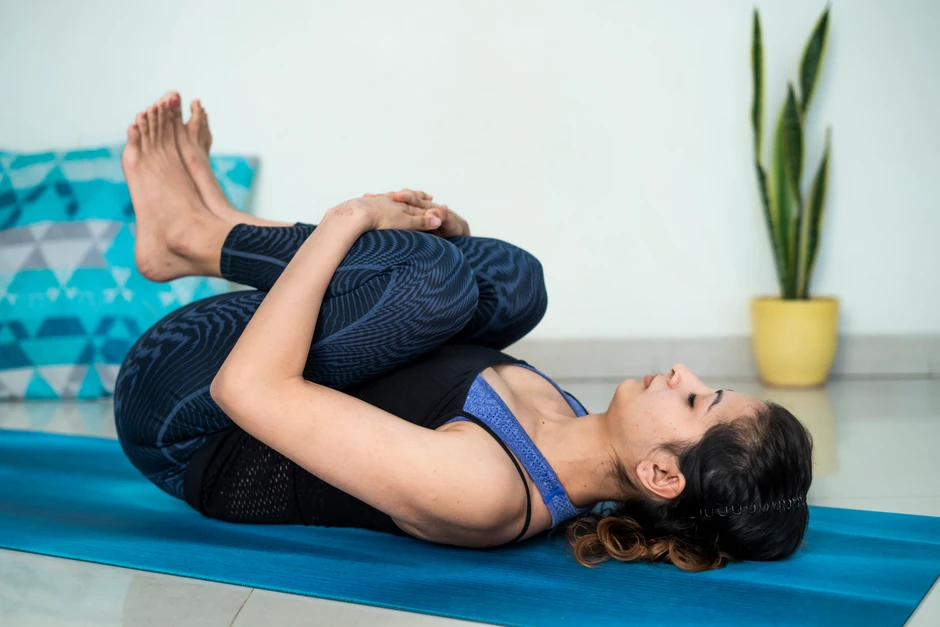
Stimulates digestion, eases bloating, and releases lower back tension.
- Lie flat on your back and bring one or both knees toward your chest.
- Hug your knees or shins gently, keeping your shoulders and head relaxed.
- Rock side to side slowly to massage the lower back and abdomen.
4. Happy Baby Pose (Ananda Balasana)
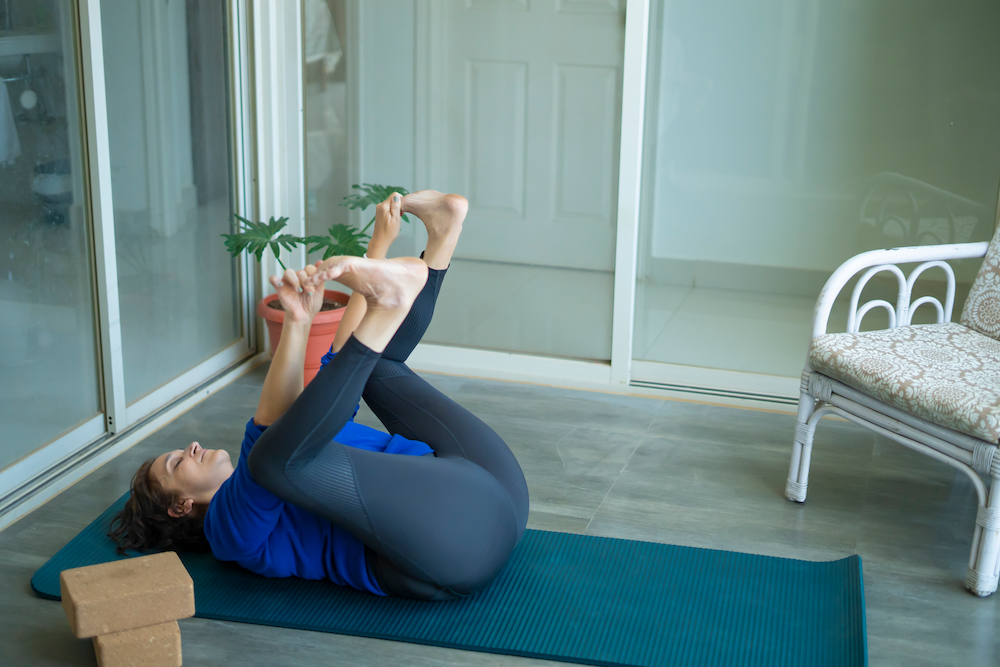
Opens inner thighs and hips while releasing tension in the sacrum and lower spine.
- Lie on your back and bend your knees toward your chest.
- Hold the outsides of your feet, ankles, or shins with your hands.
- Draw the knees gently toward the armpits, keeping ankles above knees.
5. Seated Spinal Twist (Ardha Matsyendrasana)
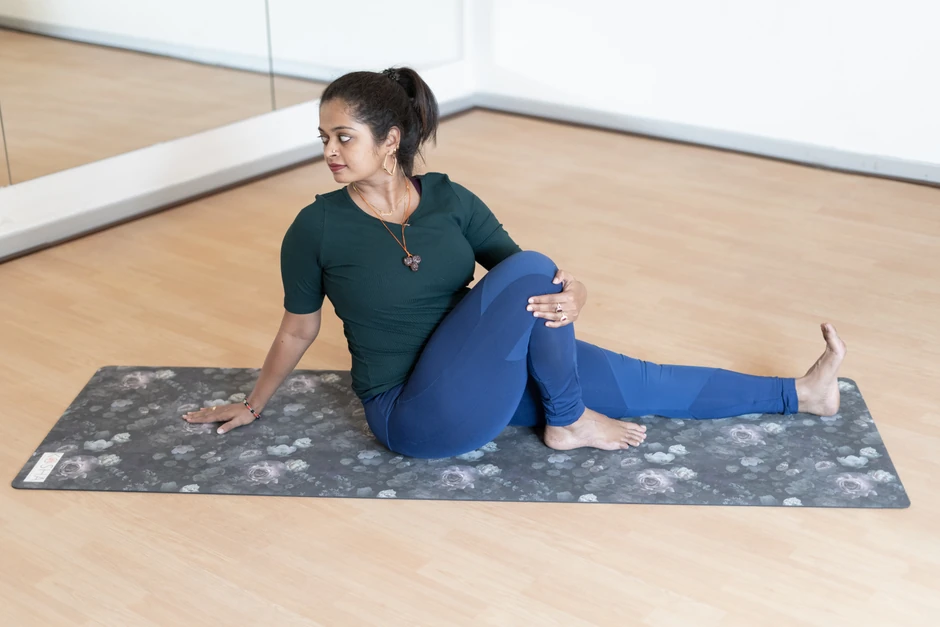
Strengthens and lengthens the spine while improving spinal flexibility and digestion.
- Sit tall with both legs extended, then bend your right knee and place the foot outside your left thigh.
- Inhale to lengthen the spine, then exhale to twist gently to the right, placing your left elbow outside your right knee.
- Keep your spine tall and shoulders relaxed as you hold for a few breaths.
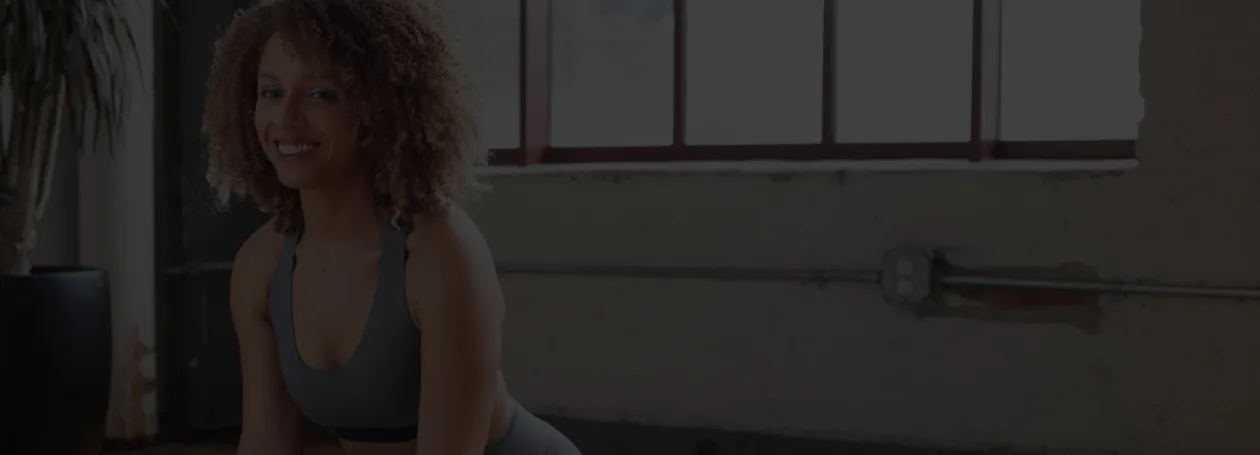
Enjoy a Free 1-on-1 Session with a Coach!
Receive personalized guidance tailored to your unique fitness goals, live with a dedicated coach—no credit card required.
Frequently Asked Questions
Supta Matsyendrasana (Supine Spinal Twist) gently stretches the spine, hips, and shoulders while releasing deep tension from the lower back. It promotes spinal mobility, aids digestion, and activates the parasympathetic nervous system — helping calm the mind and reduce stress.
Hold the pose for 30 seconds to 3 minutes per side, depending on comfort and experience. In restorative practice, you can stay up to 5 minutes with proper support under the knees to encourage relaxation and gentle spinal release.
Absolutely. Supta Matsyendrasana is one of the most beginner-friendly spinal twists in yoga. Using props like a blanket or cushion under the knees makes it accessible and safe for all levels. It’s ideal for easing into spinal movement and ending a yoga session with calm and balance.
The best time to practice Supta Matsyendrasana (Supine Spinal Twist) is at the end of your yoga session or before bedtime. It helps the body cool down, releases residual tension from deeper poses, and prepares the nervous system for rest.
You can also do it anytime during the day to relieve back stiffness or stress from sitting for long hours. Just ensure your stomach is light or empty for maximum comfort.
Both are reclining twists, but Supta Matsyendrasana is a gentle, restorative twist with knees bent and supported, focusing on relaxation and breath.
Jathara Parivartanasana is a more active variation where the legs are often extended and core muscles engage to control movement — offering a deeper spinal and abdominal challenge.
Supta Matsyendrasana is practiced lying on the back, emphasizing relaxation, spinal decompression, and breath awareness.
Seated Matsyendrasana (Ardha Matsyendrasana) is performed upright, requiring more strength and flexibility while enhancing spinal length and core engagement.



.webp)
%20(7).jpg)
